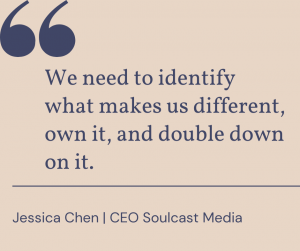Developing Your Executive Presence At Work
Developing executive presence is critical to being seen as leaders at work. Executive presence is how you carry yourself, how you speak, and how you treat other people.
According to a recent survey, executive presence accounts for 26% of what it takes to get a job promotion. If you want to be seen as a leader, you’ve got to develop your executive presence.
 Our CEO and Founder, Jessica Chen, recently hosted a Soulcast Media | LIVE event on LinkedIn, where she interviewed Chief Culture Curator at Merging Path Coaching, Brooks E. Scott. They shared tips and personal stories about developing executive presence at work.
Our CEO and Founder, Jessica Chen, recently hosted a Soulcast Media | LIVE event on LinkedIn, where she interviewed Chief Culture Curator at Merging Path Coaching, Brooks E. Scott. They shared tips and personal stories about developing executive presence at work.
1. Executive Presence
When we think about executive presence, we often compare ourselves to the people we see in leadership positions. While it’s not wrong, by focusing on others too much, we miss out on a crucial part of what builds our executive presence – doing it authenticity.
Consider the following:
- Our Style – During the Soulcast Media | LIVE, Brooks talked about how we each have a unique leadership style. When we think about developing our executive presence, we have to ensure we bring our own unique approach to what we are doing. We don
 ‘t need to copy someone else’s style, especially if it isn’t authentic to who we are. For example, let’s say another leader in our organization starts their meetings by getting everyone to laugh with a joke. We don’t need to emulate that if it isn’t authentic to who we are. The key is to ensure we are embracing our unique leadership and communication style.
‘t need to copy someone else’s style, especially if it isn’t authentic to who we are. For example, let’s say another leader in our organization starts their meetings by getting everyone to laugh with a joke. We don’t need to emulate that if it isn’t authentic to who we are. The key is to ensure we are embracing our unique leadership and communication style.
We don’t need to copy someone else’s style for others to see us as leaders. Instead, we can focus on what makes us unique, and build our authenticity.
2. Mindset
Our mindset can have a significant impact on developing our executive presence. If we feel like we belong in the room, we will act like we belong there. Consider the following:
- Narrative – The stories we tell ourselves are powerful because they turn into feelings. The feelings turn into behavior, such as how we walk into room, present ourselves, and more. For example, if we tell ourselves, we don’t belong in the room, we might sit in the back and keep our head down and avoid attention. Our narrative will shape our action.
- Clarity of Thoughts – During the Soulcast Media | LIVE, Brooks talked about the clarity of our thoughts. He said it is important to determine what we are trying to convey to others. We need to be clear, concise, and understandable. Taking time to prepare, to breath, to calm ourselves can help ensure our mindset is where it needs to be to perform.
Focusing on our mindset and ensuring we are removing negative thoughts will help us develop our executive presence at work.
3. Communications
One of the most important things we can do to develop our executive presence is to ensure we are improving our communication skills. If we can’t clearly communicate, people won’t listen to what we have to say.
Consider the following:
- Clarity of Message – During the Soulcast Media | LIVE, Brooks talked about how we need to speak clearly everyday, everywhere, and with everyone. If we ever find ourselves losing our train of thought, a great way to get back on track is to say, “The point I’m trying to make is…” When we do this, we refocus the attention of the audience and ourselves.
- Audience – Developing executive presence requires us to keep our audience in mind. For example, we need to ask ourselves, what does our audience care about? We can tailor our message to ensure we are speaking about what they care about. If we hold a staff meeting, be sure to consider their contributions, their perspectives and what they need to get out of it. The more tailored we are in our communications, the more people will listen.
We can learn how to develop executive presence at work, even if we aren’t in a leadership position. Striving to be authentic, keeping a positive mindset, and growing in our communications will help us be seen as leaders at work.
Check out Jessica’s Youtube Channel to see the full LIVE version of Jessica and Brooks’ conversation.
__
Whenever you’re ready, there are 3 ways we can help you:
- Discover your communications style so you know where to start. Over 4,000 people have found theirs here.
- Attend our monthly communication workshop to build communications confidence (new topics: public speaking, advocating for yourself, building credibility, etc) here.
- Get your brand in front of 43k+ people by sponsoring our newsletter or Soulcast Media | LIVE LinkedIn events [contact: hello@soulcastmedia.com]











